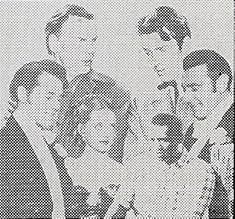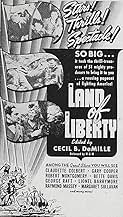This film tells the history of the United States from pre-Revolution through 1939.This film tells the history of the United States from pre-Revolution through 1939.This film tells the history of the United States from pre-Revolution through 1939.
Don Ameche
- Alexander Graham Bell
- (archive footage)
Heather Angel
- Virginia Randolph (edited from 'Daniel Boone')
- (archive footage)
George Arliss
- Alexander Hamilton (edited from 'Alexander Hamilton')
- (archive footage)
Edward Arnold
- Diamond Jim Brady (edited from 'Diamond Jim')
- (archive footage)
Felix Aylmer
- Lord Palmerston (edited from 'Victoria the Great')
- (archive footage)
Beulah Bondi
- Mary Wilkins (edited from 'Of Human Hearts')
- (archive footage)
- Director
- Writers
- All cast & crew
- Production, box office & more at IMDbPro
Storyline
Did you know
- TriviaThis film was produced by the Motion Picture Producers and Distributors of America (MPPDA-later MPAA) to be shown at the United States Government Building at both the New York World's Fair and San Francisco Golden Gate International Exposition held in 1939 - 1940.
- Alternate versionsA shortened version was released to theaters in 1941.
- ConnectionsFeatures Drums Along the Mohawk (1939)
Featured review
The film was the motion picture industry's contribution---hence the MPPDA production credit--- to the New York and San Francisco World's Fairs, where it was shown daily throughout the run of both expositions. It was sponsored by the Will Hays organization, and Hays himself worked closely with Cecil B. DeMille and James T. Shotwell, Bryce Professor of History of International Relations at Columbia University, the two individuals who contributed---a key word---most in time and effort. The object was to scan the previous 25 years (1913-1939)of Hollywood production, coupled with newsreel contributions, and build up a panorama of the drama of American history, and the social and economic developments through the various historical eras down to 1939 as seen through the previous 25 years of film production.
DeMille undertook the responsibility of assembling and editing the film. A mass of potential material was examined in Hollywood, where the dubbing, recording, cutting and physical preparation of the negative were handled. Seletion of material involved examining over 2,000,000 feet of film and the completed production ran 14 reels (137 minutes.) The oldest film represented was from D. W. Griffith's "America" (1914)and the most recent was from Warner's "The Bill of Rights", a short subject in their historical series.
The editing and matching of scenes sometimes involved more than one film in various sequences, as in the segment covering the last day in the life of Abraham Lincoln, starting with a meeting with his cabinet and concluding to his departure for Ford's Theater; this sequence was composed from 1930's "Abraham Lincoln" and 1936's "The Prisoner of Shark Island." Seven of the American presidents are portrayed by actors, while Teddy Roosevelt appears in three different stages of his career from newsreel clips, and Presidents Woodrow Wilson and Franklin D. Roosevelt (who opens and closes the film) also appear via newsreel footage.
The finished product contained footage from 125 feature films and short subjects and countless newsreel shots. At the close, an alphabetical list gives credit to the various individuals and organizations contributing to the production by donating---key word---their film properties, money and time.
And, yes, one of the stated purposes was to instill a love of country in the minds of the youth of the country, and the new citizens of foreign birth. And, close to the majority of the people who worked on and paid for this production beyond the donation of the property rights (with no monetary return expected) were born outside of the United States..and damn glad they were now U.S. citizens.
DeMille undertook the responsibility of assembling and editing the film. A mass of potential material was examined in Hollywood, where the dubbing, recording, cutting and physical preparation of the negative were handled. Seletion of material involved examining over 2,000,000 feet of film and the completed production ran 14 reels (137 minutes.) The oldest film represented was from D. W. Griffith's "America" (1914)and the most recent was from Warner's "The Bill of Rights", a short subject in their historical series.
The editing and matching of scenes sometimes involved more than one film in various sequences, as in the segment covering the last day in the life of Abraham Lincoln, starting with a meeting with his cabinet and concluding to his departure for Ford's Theater; this sequence was composed from 1930's "Abraham Lincoln" and 1936's "The Prisoner of Shark Island." Seven of the American presidents are portrayed by actors, while Teddy Roosevelt appears in three different stages of his career from newsreel clips, and Presidents Woodrow Wilson and Franklin D. Roosevelt (who opens and closes the film) also appear via newsreel footage.
The finished product contained footage from 125 feature films and short subjects and countless newsreel shots. At the close, an alphabetical list gives credit to the various individuals and organizations contributing to the production by donating---key word---their film properties, money and time.
And, yes, one of the stated purposes was to instill a love of country in the minds of the youth of the country, and the new citizens of foreign birth. And, close to the majority of the people who worked on and paid for this production beyond the donation of the property rights (with no monetary return expected) were born outside of the United States..and damn glad they were now U.S. citizens.
Details
- Runtime2 hours 18 minutes
- Color
- Sound mix
- Aspect ratio
- 1.37 : 1
Contribute to this page
Suggest an edit or add missing content





































